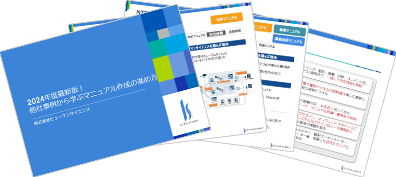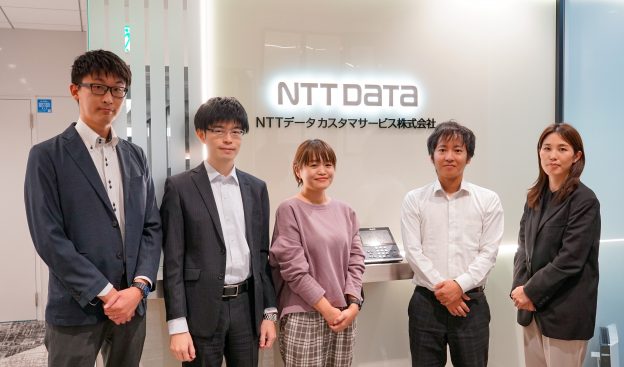


Interview Cooperation:
NTT Data Customer Service Corporation
Business Infrastructure Promotion Department, Internal Information Systems
Mr. Yasuhiro Shiomi
Overview of NTTDATA CUSTOMER SERVICE CORPORATION
- Established: March 2, 1998 (Business started on April 1, 1998)
・Capital: 100 million yen (100% invested by NTT Data Corporation)
Number of Employees: 1,080 (as of April 1, 2023)
Business Content: Contracting for planning, design, construction, implementation, operation, and maintenance of IT systems and equipment.
(https://www.nttdatacs.co.jp)
Services Utilized
・Manual evaluation, analysis, and improvement proposal services
・Manual production services
This is a project where a new manual was created for the renewal of the core business system.
After conducting a manual analysis of the existing system at Human Science, we proposed a production policy for the new manual and proceeded with its creation.
The manuals produced are of the following three types:
・Business Operation Manual: A manual that explains who uses the system and for what purpose within the flow of business (PowerPoint, approximately 100 pages)
・System Operation Manual: A manual that details the operating procedures and precautions when using the system (Word, approximately 700 pages)
・Video Manual: A manual that explains particularly important operations through videos with subtitles (operational videos, 22 pieces)
We spoke with Mr. Shiomi from NTT Data Customer Service Corporation, who is a project manager for system development and also serves as the leader of the manual production team.
Project Background
--First, please tell us about NTT Data Customer Service and Mr. Shiomi's role.
Mr. Shiomi: NTT Data Customer Service, as a member of the NTT Data Group, is a company that provides total support for the system lifecycle of our customers, including planning, design, construction, implementation, operation, and maintenance of IT systems and equipment.
One of our major features is that we offer multi-vendor services that can handle a variety of products both domestically and internationally, and we have a support system in place where IT engineers can rush to our customers from approximately 200 locations nationwide.
As a project manager for core business system development, I am responsible for overall management related to development. I also serve as the leader of the manual production team.
-- This time, we were approached to create manuals for the renewal of the core business system. Could you please provide an overview of the system?
Mr. Shiomi: This is a core system equipped with the necessary functions to provide services to our customers. We have been using the previous system for about 20 years and were accustomed to it, but we have rebuilt it to respond more flexibly to the diversifying needs of our customers.
The main functions include the ability to register information about customers and share it among stakeholders. Based on this information, we use scheduling and resource adjustment functions to coordinate specific tasks such as implementation and maintenance. In addition to accommodating various scheduling patterns, we can also manage work schedules using the function to register schedules for each location and individual.
Furthermore, we have enhanced the inventory management function and data utilization function. The inventory management function allows for more detailed management of items installed at customer sites and items owned by each location compared to the previous system.
With the data utilization function, we can register the results of work responses and operating hours, analyze the accumulated information to consider future countermeasures, and develop operational plans.
-- From the beginning, were there plans for three types of manuals: operational manuals, user operation manuals, and video-based manuals?
Mr. Shiomi: Yes, I thought three types were necessary. The users were very accustomed to the long-used conventional system, so there was a risk of inconveniencing customers due to their unfamiliarity with the new system when it was introduced.
I believed that it was essential to prepare manuals tailored to the purpose to help users quickly learn the operations and get accustomed to the new system.
Reasons for Choosing Human Science
-- Initially, we heard that you were working on in-house manual production. What challenges did you feel that led you to contact our company?
Mr. Shiomi: Even if we focus only on the features visible to users, the system has about 70 functions and approximately 230 screens, making it quite voluminous. Additionally, since these are business screens, there are several screens that are difficult to operate without understanding the business flow.
We considered which of the three types of manuals to start producing and began with the manual for business operations. However, it took a lot of time to think about how to express the business content and key points written in text in a way that would be clearly communicated in the manual. This production challenge developed into a progress issue, raising concerns about whether we would meet the deadline for completing the manual, leading us to decide to review the manual production system.
--Please tell us the reasons you chose Human Science.
Mr. Shiomi: Since I had no experience outsourcing manual production, I looked at several companies after visiting their websites.
The selection criteria we considered internally were:
・Since the target is a core business system, there should be a proven track record in technical documentation.
・The ability to manage progress and quality control of manual production.
Human Science Company has a proven track record in the technical field, and it became clear during our meetings that they have a solid management system for progress and quality.
What was particularly appreciated was their proposal to reduce our management burden. They quickly recognized the urgency of the project and sensed the situation.
From such proposals, it was evident that they have experience and a track record in creating manuals within projects, which allowed us to choose your company without feeling anxious. I believe that if we hadn't made that request at that time, the project would have faced much more difficult circumstances.
How to Proceed with the Project
-- First, we conducted a current status analysis of the manual that was partially created within NTT Data Customer Service. What were the results of the analysis?
Mr. Shiomi: In the current situation analysis, you accurately captured the areas where we felt that things were not going well. Additionally, there was a thorough hearing of the key points we wanted to convey and what we prioritize in creating the manual. Based on that, I believe you provided an analysis of the current situation.
During our weekly meetings, we discussed the quality we should aim for while gathering your opinions and requests. What was your impression of the approach we took?
Mr. Shiomi: It was very helpful to be able to discuss and present the anticipated schedule for the future, and to proceed while aligning our understanding.
Since you explained the flow of how this version leads to the final version of the manual, I was able to understand in advance things like "when we need to provide this information" and "when we need to take time to confirm during this period," which was also beneficial for securing internal operations.
Additionally, when creating manuals, we first draft a portion and then align our understanding of whether the content, structure, and writing style are appropriate before expanding it further, which allowed us to proceed without any concerns.
--At the draft stage, did you have a complete image in mind?
Mr. Shiomi: Yes. It was helpful because I never felt like I couldn't see ahead.
-- The meeting was conducted via web conference, but how was it in terms of communication?
Mr. Shiomi: It was difficult to adjust the meeting schedule according to the progress, so having a regular meeting once a week worked well.
In terms of communication, I did not feel any inadequacies with the web conference at all, and since it can be recorded and reviewed later, I believe it was the optimal way to conduct it.
About the completion of manuals and the production system
--Regarding the business content, we created the manual based on the hearing, but were there any difficulties in providing information?
Mr. Shiomi: I believe that your company has faced more challenges than we have. Since the system is not yet operational, we had to create manuals from incomplete documents, unfinished design specifications, and verbal explanations...
Despite that, it was truly impressive how quickly you were able to read the materials we provided and understand the business and system.
It is natural that you are not familiar with our operations, so we carefully considered what parts we wanted you to create and communicated the necessary content and scope, being mindful not to overwhelm you with too many details.
Could you share your thoughts on the completion of the manual?
Mr. Shiomi: I feel that the writing and expressions are concise and use a sense of unity, resulting in a very high level of completion. Since the volume was large, I thought it would be difficult to summarize the entire content with similar expressions, but you handled it well.
Additionally, I feel that you incorporated the information we conveyed into each manual from the perspective of "how users will use it in various situations."
There were times when I couldn't convey the image of how I wanted it expressed in specific words, but it was helpful that you suggested ideas like, "How about expressing it this way?"
I feel that the manuals are well-structured to fulfill their respective roles. I believe this was possible because we explained and aligned our understanding of the purpose of the manuals at the initial stages of the project.
The three types of manuals were created with an awareness of their interrelationships, rather than in isolation.
-- You mentioned that this was your first time outsourcing manual production, but how did it go?
Mr. Shiomi: When creating manuals in-house, there are often uncertainties about how much to convey due to the various levels of understanding among team members, and individual writing styles can lead to inconsistencies. This often results in numerous concerns during the review process.
By outsourcing to a company with expertise and know-how in production, we were able to receive deliverables that met a certain standard in terms of expression. As a result, we could focus on verifying the accuracy of the content, which reduced the time spent on reviews. Additionally, not only in terms of quality but also in managing progress, we entrusted everything to them and they handled it smoothly.
The ability to compress the overall time involved in the manual was extremely significant for the progress of the project.
I have come to believe that having an external party objectively review and select information can sometimes lead to better manual creation.
Effects After Manual Release
-- How has the impact been after the release of the manual?
Mr. Shiomi: I believe that the manual clearly explains how to operate the system, and if you follow the instructions as written, you can use it effectively. The absence of complaints about the manual being difficult to use is likely because it has been created to a certain standard.
At the help desk, we provide support to users based on the manual. We guide users to the relevant sections of the manual in response to their inquiries, and we display the manual on the screen to explain how to operate it.
We designed the manual to be easy to operate and update, so that it can accommodate additional features. How is the ease of use?
Mr. Shiomi: As you showed the overall structure of the manual in the initial stage, the overall design is consistent. Thanks to that, when additional items arise for the manual, I can smoothly think, "If this is the content, I will add it here in this way." I believe it is designed to be easy to operate and update.
Future Plans and Outlook
-- Finally, could you share your plans and outlook regarding your responsibilities?
Mr. Shiomi: The renewal of our core business system is the first step towards the future vision and grand design we envision. Moving forward, we aim to enhance customer service quality and provide information collaboration services to our clients by adding options to this new system.
Internally, we want to reduce the burden on IT engineers who rush to assist our clients, creating an environment where employees, including IT engineers, can focus more on customer service.
Through these efforts, we want to embody our corporate philosophy of being a company that nurtures our clients' "systems," fosters their "businesses," and cultivates their "futures."
Thorough introduction of case studies on manual creation from other companies!Learn from case studies of other companies
How to proceed with manual creation
Before starting to create a manual, by learning about other companies' manual creation examples, you can understand the "key points of creation" and "common challenges" to gain hints for manual creation.
Recommended for
- I want to proceed with manual creation, but there is too much volume, and I don't know where to start.
- ・I am unsure if I can accomplish what I want to do in-house
- ・I want to know how other companies are progressing with manual creation

[Introducing Companies]
- TOTSUMEDIA Inc.
- BANDAI SPIRITS CO., LTD.
- NTT DATA KANSAI CORPORATION
- SBI SECURITIES Co.,Ltd.
- NNTTDATA CUSTOMER SERVICE CORPORATION
- WingArc1st Inc.
- Nippon Sheet Glass Co., Ltd.



